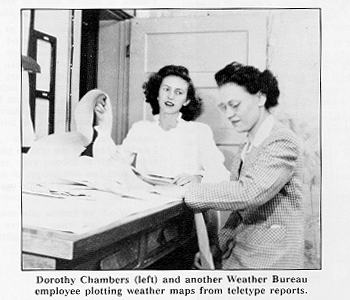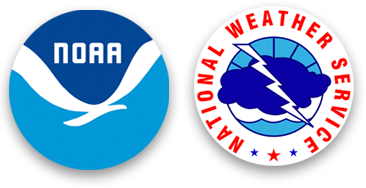Women in the Weather Bureau During WWII: Dorothy Hurd Chambers - National Weather Service Heritage

Women in the Weather Bureau During WWII: Dorothy Hurd Chambers
By NWS Heritage Projects Editorial StaffEditor’s Note: The following first-person account of Dorothy Hurd Chambers first appeared in Women in the Weather Bureau During WWII by Kaye O'Brien and Gary Grice, 1991.
I worked for the Weather Bureau from January 1944 to 1948. My assignments were at Denver Stapleton Field and one year at Lander, Wyoming. I was always interested in weather and needed a different job. I had heard that the Weather Bureau was giving tests for jobs so I took it and passed. They sent me to Kansas City for a six-week training course. Then I was sent to Denver to my great pleasure. While there I used my maiden name, Hurd, as I was not married then. My age was about 29. I left the Weather Bureau in 1948 because I was tired of working shifts. My previous background experience had included one and a half years at a teachers' college art school. In 1942 I left Florida IO go to St. Louis to work for Curtis-Wright Aircraft Factory. Worked on drawings for new airplanes. In 1943 the work slowed down and I spent a lot of time in the library. Some books on meteorology were fascinating, so I thought I'd like to get into that. The airport (at Denver) was pretty small and not very busy but we had full days taking the observations and sending up the balloons and radiosondes. I was received very cordially by the other Weather Bureau employees. There was no discrimination at all. Working at the Weather Bureau was fascinating. I was an observer. My duties included taking observations every hour and half-hour, sending up ceiling balloons every six hours, radiosonde balloon flight every six hours, and putting coded messages on teletype. The shifts were 5:30 AM - 2:00 PM; 3:30 PM - 11:30 PM; 11:30 PM -8:00 AM. We worked 8 hours a day, forty hours a week. There were no lunch hours, we brought our lunch and ate in the office while working. There were perhaps forty employees at Denver, twelve at Lander. There were seven of us (women) that I remember in Denver. In Lander there were four women observers. As pay, it seems like we got $90 for two weeks the first years.
The morale on station was very good. I loved working there. In Lander, the town people were very friendly and included us in their activities. The staff were like brothers and sisters. We went hiking together in the mountains, etc.
I liked doing a RAOB. That was a high point of my career. Also, we were all sociable. There were no low points, but some scary times when we observers had to tell the tower they had to send planes somewhere else or go to instrument landing when the ceiling or visibility was low. The tower men didn't like us "young girls" telling them what to do. But we didn't have any crashes at Denver anyway.
My year at Lander, Wyoming, was fun, just sending in the observations and radiosondes. It was a great town to live in near the mountains and full of real westerners. By working for the Weather Bureau during World War II, I felt we were doing something very important to help keep the airlines and the military planes going. I would do it again. It was more interesting than a desk job even when weather was rough. I feel that my major contributions were finding the jet stream and helping the military planes.
In Lander, on the 3rd of July, I was all alone at the mesa where the weather station was, a whole lot of Indians camped and practiced their dances for the parade at night. They were from Wind River Reservation. No danger, but unusual experience. I think one woman observer in the northeast was killed in a forest fire. Many of them had to walk to work in all kinds of weather, night and day. We are all getting pretty old, but I'll bet most are active.
[Ms. Chambers has included a newspaper clipping which she had written. It is from the Colorado OLD TIMES, dated December, 1986, and entitled, "We Found the Jet Stream". In regards to this, she gives the following statement.] I believe we did, too. The gasoline engines couldn't go very high and jet engines were just being developed. Sitting at that drawing board and plotting the theodolite readings, it was amazing to me to get readings above 30,000 feet of 80 - 120 mph or more. The pilots were amazed too.
Our ceiling balloon would often start out toward the mountains. Then suddenly it would come back fast, with us twirling the knobs as fast as we could to keep it in sight as it sailed east. Later, when plotting the run on a chart, we would discover amazing wind speeds of 80-100 mph at 30,000 feet or so. In those days planes flew much lower so they hadn't discovered the jet stream. Now it is used routinely and planes often get in ahead of schedule. Also the jet stream's position determines the weather pattern.
We were told, "Women can't do this kind of work." That was in 1942, and trained weather observers were desperately needed. Trainees were scarce as men were drafted or enlisted. The only possibilities were we women. They had to let us try this technical, rugged, outdoor work. We tried it. We succeeded! We proved them wrong and practically ran the weather stations for the rest of the war.
We, girls in our 20's mostly, walked or drove to our jobs all over the country in all kinds of weather, all hours of day and night. We learned to make the vital weather observations that the pilots depended on. Mere girls decided when planes could take off or land. Sometimes the pilots would come in and try to get us to change our ceiling or visibility report. Handsome, glamorous pilots were pretty hard to resist but we stuck by the rules.
We girls showed the world that "man's work" could be women's work too. We even taught some men from the Air Force and several foreign countries. Some women stayed on after the war, many got married, or got tired of working shifts. I left to go back to drafting with the Highway Dept. It has always been a great satisfaction that I was privileged to be a part of aviation history.
